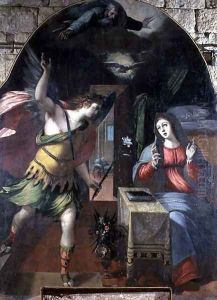Wenzel Coebergher Paintings
Wenzel Coebergher was a multifaceted Flemish artist, architect, engineer, and economist who made significant contributions during the late Renaissance and early Baroque periods. Born in 1561 in Antwerp, which was then part of the Spanish Netherlands, Coebergher was a product of the cultural and economic hub of Europe during the time. He was trained as a painter and was also skilled in engraving and sculpture. His artistic talents were recognized early in his career, and he became a master in the Antwerp Guild of Saint Luke by 1585.
Coebergher's work extended beyond the confines of traditional artistry. In 1597, he was appointed as the architect and engineer to Archduke Albert VII of Austria and his wife, Infanta Isabella Clara Eugenia of Spain, who were then the sovereigns of the Spanish Netherlands. In this role, Coebergher worked on numerous projects including the design and oversight of fortifications and infrastructure. Notably, he was involved in the restoration of the Brussels Almshouse and the construction of the Basilica of Our Lady of Scherpenheuvel, which is considered one of his architectural masterpieces.
His expertise was not limited to the arts and architecture; Coebergher was also an economic advisor to the archducal court. He played a key role in reforming the monetary system of the Spanish Netherlands, proposing the establishment of a centralized mint and the standardization of coinage. His efforts helped stabilize the currency and boost the economy of the region.
In addition to his secular work, Coebergher was deeply religious and a member of the Confraternity of the Rosary. This piousness influenced his art and architecture, which often featured religious themes and was imbued with a sense of devotion. His work in the promotion of the Catholic faith aligned with the Counter-Reformation efforts of the time, further endearing him to the Catholic Habsburg rulers.
Wenzel Coebergher passed away in 1634, leaving behind a legacy of artistic and architectural works that continue to be appreciated for their craftsmanship and historical significance. His multi-disciplinary approach and contributions to both the arts and the economic stability of his region make him a notable figure in the cultural history of the Low Countries during the transition from the Renaissance to the Baroque period.
